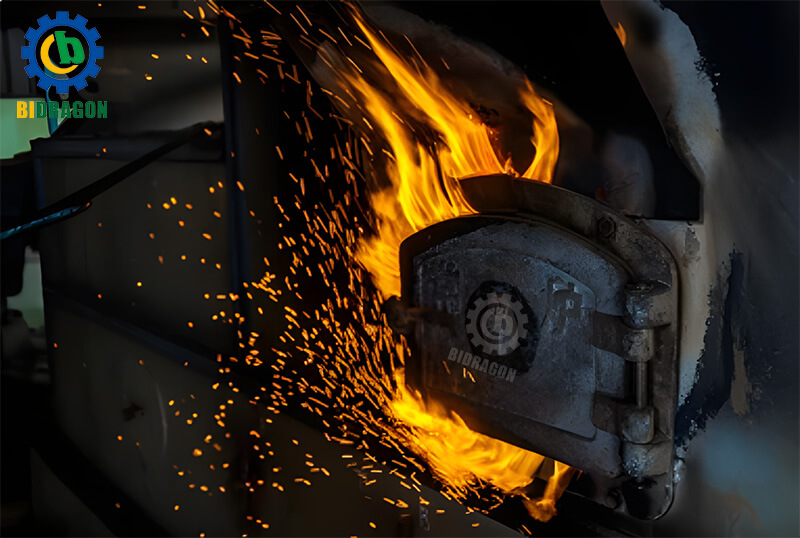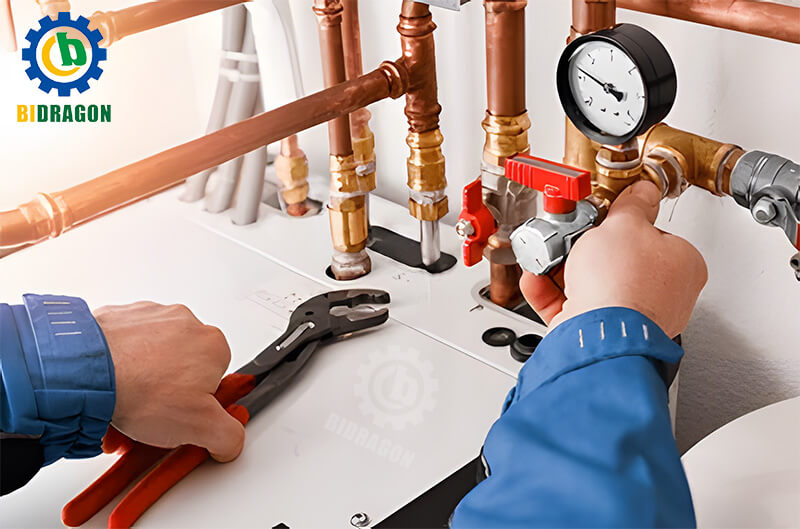In the modern industrial system, industrial boilers as the core thermal energy equipment, widely used in manufacturing, chemical, food processing and many other fields. The scientific and standardized nature of its installation process directly affects the operational efficiency of the equipment, production stability and the operating costs of the enterprise. This paper will discuss the key factors that must be considered in the installation process of industrial boilers.
The industrial boiler plays an integral role in industrial production. In the manufacturing industry, it provides steam to the production line for heating, drying, cooking and other processes; in the chemical industry, high-temperature and high-pressure steam is a key energy source for chemical reactions; in the field of food processing, hot water boilers guarantee the safety and hygiene of food sterilization, cleaning and other aspects.
Choosing the right type of boiler is crucial. Steam boilers are suitable for high-temperature and high-pressure steam scenes, such as textile printing and dyeing, papermaking, etc.; hot water boilers are commonly used in heating, food processing and other industries with a greater demand for hot water; thermal oil boilers can provide high-temperature heat under low pressure, is widely used in chemical industry, asphalt production and other fields.
Technical parameters directly affect the efficiency of the boiler and energy consumption. Thermal efficiency determines the degree of energy utilization, the higher the thermal efficiency, the less energy waste; evaporation reflects the boiler's heat production capacity, need to be determined according to the actual heat demand; the choice of fuel type is closely related to the cost, environmental protection requirements, natural gas is clean and efficient, but the cost of higher, low-cost biomass fuels, but need to consider the stability of supply. The right industrial boiler can ensure stable production capacity and reduce long-term operating costs, while the opposite may lead to energy waste and low production efficiency.

Industrial boiler sizing requires precise calculation of heat load and process demand. By analyzing the data of heat-using equipment, heat-using time and heat-using quantity in the production process, combined with the heat loss calculation, an accurate heat load value can be obtained, based on which a suitable boiler capacity can be selected.
Plant conditions constrain boiler selection. Small space may limit the installation of large boilers, insufficient load-bearing will affect the safe operation of the boiler, poor ventilation may lead to insufficient combustion, exhaust gas accumulation. Therefore, when selecting the type, it is necessary to give full consideration to the space size of the plant, load-bearing capacity and ventilation conditions.
Boiler load changes frequently, need to have good regulation ability. Boilers with large regulation ratio and fast response speed should be selected to ensure stable operation under different working conditions. At the same time, it is not possible to focus only on the thermal power of the boiler, but also need to consider the load of auxiliary systems, such as feed pumps, fans and other equipment power requirements, to avoid the situation of “small horse-drawn carts”.
Site preparation and structural evaluation is the basic work for the installation, removing debris and leveling the ground to create good conditions for the installation. Evaluation of the strength of the foundation is essential to design a suitable foundation based on the weight of the boiler, vibration during operation, and other factors to ensure that its load-bearing capacity meets the requirements.
The installation area needs to meet safety distances and explosion and fire prevention standards. Maintain sufficient spacing from buildings and other equipment, and set up facilities such as firewalls and explosion-proof doors to prevent the spread of accidents. At the same time, plan the transportation and lifting path of the boiler body to ensure that the equipment can reach the installation location safely and smoothly.
The reasonable layout of the boiler room should take into account the boiler body, auxiliary equipment, control cabinets and maintenance access. Centralized arrangement of related equipment facilitates operation and maintenance, while leaving enough space for equipment maintenance and personnel access.
Modular and integrated industrial boiler systems have their own advantages. Modular systems are flexible and easy to expand later; integral systems are compact and efficient. It is necessary to choose the appropriate deployment method according to the actual needs. In addition, in accordance with ASME, GB and other standards, typical layout dimensions and space for cleaning and maintenance are set aside to ensure safe operation and easy maintenance of the equipment.
Auxiliary system includes deoxygenation tank, boiler feed water pumping unit, energy saver, discharge expansion tank, etc. These equipments need to be installed in conjunction with the main boiler. The installation of these equipments should be closely coordinated with the boiler body to ensure stable operation of the system. Fuel system access needs to be based on the type of fuel to select the appropriate piping, valves and other equipment, and to ensure its sealing and safety. For natural gas, diesel and other conventional fuels, as well as biomass, steam condensation recovery and other new energy utilization, should be installed in strict accordance with the specifications.
The installation of flue gas emission equipment is directly related to environmental protection standards, and equipment such as SCR (selective catalytic reduction) and ESP (electrostatic precipitator) should be installed accurately according to the design requirements and debugging should be carried out to ensure that the flue gas emission complies with the environmental protection standards.
The control system and PLC/SCADA platform access wiring should follow the electrical specifications to ensure stable and accurate signal transmission. Calibration of instrumentation points and linkage debugging is the key to ensure the safe operation of the boiler, temperature, pressure, water level and other parameters need to be accurately monitored in real time and realize automatic control.
Frequency converters, electric valves, control cabinets need to pay attention to the installation of correct wiring, good grounding, to avoid electrical failures affecting the operation of the boiler. At the same time, the control system should be functionally tested to ensure that the linkage between the equipment is normal.
The installation of industrial boilers is subject to a strict licensing process to obtain special equipment permits. The installation process must comply with national / regional regulations, such as “Boiler and Pressure Vessel Safety Technology Supervision Regulations”, to ensure the quality and safety of the installation.
After the installation is completed, acceptance, inspection and performance testing are required. Invite professional organizations to test the performance indexes of the boiler, such as thermal efficiency, pressure test, flue gas emission, etc., and the boiler can be put into use only after passing the test.
Before starting up, a comprehensive inspection should be carried out, including whether the water, electricity and gas supply is normal, and whether the safety chain system is reliable, etc. Only when all the conditions meet the requirements can the boiler be started up. Only when all the conditions meet the requirements can the next operation be carried out.
Burner commissioning is a key part of the start-up process, which requires adjusting the combustion parameters to ensure sufficient and stable combustion, and conducting emission tests to ensure that the pollutant emissions meet the standards. Initial operation status monitoring and process system linkage verification should be carried out continuously to find and solve problems in time to ensure the stable operation of the boiler and the whole production system.
Space and layout constraints limit the boiler type and piping routes. In the case of space constraints, it is necessary to choose a compact boiler and optimize the piping layout to reduce elbows, valves and other resistance components. Production processes have specific requirements for boiler performance curves, such as certain processes require rapid start-stop boiler, pressure fluctuations, which requires full consideration in the design phase, select the appropriate type of boiler and control mode.
The space for auxiliary equipment is also important, such as chemical water system, energy saver, backup boiler module, etc. It is necessary to arrange the space reasonably to ensure its normal operation and maintenance.

Common installation errors in industrial boiler projects include ignoring the installation sequence and linkage logic of the boiler and auxiliary equipment, resulting in improper or inefficient operation of the equipment. Poorly designed ventilation and flue gas discharge can result in inadequate combustion and poor exhaust gas discharge, affecting boiler performance and environmental safety.
Without full-process debugging, the system is prone to interlock false alarms during operation, interfering with normal production. In addition, the lack of complete operation and maintenance training after installation and the unfamiliarity of operators with the equipment may lead to improper operation and safety accidents.
Before installing a new boiler, it is necessary to assess the energy system and load analysis, to understand the existing energy supply and actual heat demand, to provide a basis for the selection and installation of the new boiler.
Rationalize the project schedule and select a suitable shutdown window to minimize the impact on production. At the same time, formulate safety and civilization construction measures, regulate the fire, aerial, lifting and other operations to ensure that the construction process is safe and orderly.
The cost of industrial boiler installation includes direct cost and indirect cost. Direct costs mainly include boiler procurement costs, auxiliary equipment costs and installation engineering costs; indirect costs include production stoppage losses, time costs due to safety supervision and approval cycle, commissioning and test run costs.
From a long-term perspective, fuel costs, operational efficiency and environmental compliance costs are also important factors. Choosing an energy-efficient and environmentally compliant boiler can reduce long-term operating costs, although the initial investment is higher.
In order to realize the long-term stable operation of industrial boilers, we should formulate the “Installation - Commissioning - Operation and Maintenance” full-process delivery system to ensure that each link meets the standards and requirements. Participate in the design stage in advance and make suggestions from the perspective of installation and operation to ensure the consistency of construction and operation.
Establish boiler operation data monitoring mechanism, real-time monitoring of the boiler's various operating parameters, through data analysis to achieve energy-saving optimization and fault early warning, to improve the reliability and economy of the equipment.
Industrial boiler installation is a systematic and complex project, the successful implementation of which depends on the precise control of each link. From the scientific selection of boiler types and specifications in the early stage, to site preparation, layout planning, coordination of auxiliary systems, electrical instrumentation installation and other detailed operations during the installation process, and then to the later compliance certification, commissioning and start-up, each step is closely related and interacts with each other. Negligence in any of these areas can lead to operational inefficiencies, safety hazards, or increased costs. Only by fully considering the key factors outlined in this article and following standardized processes and best practices can we ensure the efficient, stable and safe operation of industrial boilers and provide solid and reliable thermal energy for industrial production.